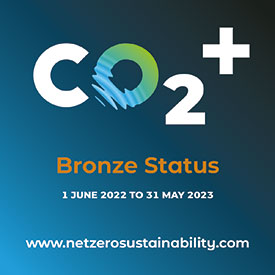Climate Change
Carbon Footprint
What is your Carbon Footprint?
Why calculate your emissions?
More and more companies want to, or are obligated to communicate their greenhouse gas emissions – for example in the course of Environmental or Energy Management Systems and for sustainability reporting. Additionally, CO2 emissions are becoming an increasingly important criterion in the investor decision-making process. Apart from this, commitments in climate protection measures may be useful for marketing activities.

Why verify your Carbon Footprint?
Companies enhance their credibility and transparency towards clients, investors and the public by having their calculations and assertions checked by an independent, competent and well-recognised party.
Our Services
- Calculation of a Corporate Carbon Footprint according to ISO 14064-1
- Support with Third Party Verification
- Verification of a Corporate Carbon Footprint according to ISO 14064-3
To avoid any conflict of interest, our team would not verify a carbon footprint which they have calculated.
GHG Emission Reduction projects

What are GHG emission reduction projects?
GHG emission reduction projects include a variety of technologies, which lead to GHG emission reductions, e.g. agriculture, energy or transport.
Credible GHG emission reduction projects adhere to the requirements of recognised programs such as the CDM, Gold Standard or VCS. Certified projects will be issued tradeable GHG credits.
Need for GHG emission reduction projects
Organisations around the world are recognising the importance of climate change, and are thus trying to reduce GHG emissions. Those emissions, that cannot be avoided may be neutralised or offset by using carbon credits, generated by certified emission reduction projects.
Development of Project Documentation
In order to officially register a GHG emissions reductions project, the Project Proponent (PP) must develop a set of documents which complies with the requirements of a methodology, which is related to the technology used. The main document is known as the Project Design Document (PDD).
Verification Process
Each project follows a two-step process of validation and verification. During the validation phase, the project design is assessed against the chosen project development requirements, which is a prerequisite for registration of a project. Verification is a periodic review to determine the actual GHG emission reduction related to the project activity.
Our Services
We can help you to:
- Develop the Project Design Document
Provide you with Validation and Verification according to the following GHG emission reduction programs
- Clean Development Mechanism Development
- Gold Standard
- Verified Carbon Standard (VCS)
To avoid any conflict of interest, out team would not validate or verify a project for which they have developed the Project Design Document (PDD).
Carbon Positive Solutions for SME'S
Need for such a service.
Small and Medium Enterprises (SMEs) make up more than 99% of the UK business population. As such, their impact on climate change is not insignificant. Since a reduction in carbon emissions results in a direct improvement in the bottom line, it could be argued that the impact on SMEs is more valuable than for larger businesses.
We are providing a low cost, high value service to SMEs to ensure that their carbon footprint is independently calculated and that they go beyond carbon neutrality but rather become carbon positive.
This means that we can help you offset 20% more carbon than you emit in the year. The offsets (carbon credits) purchased are from projects which have a significant impact on the local community and are aligned with some of the United Nations Sustainable Development Goals (SDGs).
We are providing a low cost, high value service to SME’s to ensure that their carbon footprint is independently verified and that they go beyond carbon neutrality but rather become carbon positive. This means that they offset 20% more carbon than they emit in that year. The offsets (carbon credits) purchased are from projects which have a significant impact on their local community and are aligned with some of the United Nations Sustainable Development Goals (SDG’s).

What's in it for my company?
There are increasing demands on SMEs to demonstrate that they recognise their impact on climate change and are doing something about it. Many local and national government tenders include the need to demonstrate sustainability credentials. If your company is part of a larger supply chain, you may be asked to provide your carbon footprint to your supplier, as that forms part of theirs.
Green Procurement is becoming increasingly important, since any reduction in the carbon footprint of a product reduces the carbon footprint of a purchaser.
There is much more consumer awareness around Climate Change these days and they want to know about the green credentials of the company’s that they are buying from.
Your carbon positive journey
Every journey must start somewhere and it is no different when becoming Carbon Positive. Our Carbon Positive journey has four status levels; Bronze, Silver, Gold and Diamond. Progression through the different status levels demonstrates the reduction in your carbon footprint over time.
The very first year that we calculate your carbon footprint is referred to as your baseline or base year and at this stage you will be awarded Bronze status. To progress through the various tiers you must demonstrate a year-on-year reduction in your carbon footprint of 10% compared to your baseline emissions. To obtain Diamond status you must have demonstrated a 40% decrease in your carbon footprint, compared to your baseline emissions.




Benefits of the Service
The output from the engagement will provide you, the client, with a good understanding of which aspects of your business activities contribute to your overall emissions. This will enable you to try and identify where emissions, and hence cost savings, can be made. The purchase of offsets results in the support of various community projects in less developed countries and allows you to incorporate this into your CSR and marketing activities. So it really is a win-win situation.
Carbon Credits
- Carbon credits are purchased from verified and registered projects.
- They provide long term measurable benefits, as well as meeting some of the UN Sustainable Development Goals (SDG’s)
- The credits are sourced from a well respected and leading provider, ClearBlue Markets.
Our Services
- Calculation of the carbon footprint according to an Internationally recognised standard.
- Purchasing sufficient offset credits to enable the client to become carbon positive.
- Provide report and certificate confirming this.
- Information regarding the project from which the offsets are purchased and the good which that project is doing.
What is SECR?

Who needs to comply?
- Quoted companies of any size that are already obliged to report under mandatory greenhouse gas reporting regulations.
- Unquoted companies incorporated in the UK that meet the definition of ‘large’ under the Companies Act 2006 will have new reporting obligations. This applies to registered and unregistered companies. Note that the criteria for ‘large’ differs from the ESOS Regulations.
- ‘Large’ Limited Liability Partnerships (LLPs) will be required to prepare and file a ‘Energy and Carbon Report’.
- Unquoted companies or LLPs are defined as ‘large’ if they meet at least two of the following three criteria in a reporting year:
– a turnover of £36million or more;
– a balance sheet of £18million or more; or
– 250 employees or more.
Public bodies do not fall under the new regulations, but they are subject to other legislation which requires carbon reporting.
It is worth noting that charities, not-for-profit companies or others undertaking public activities – such as companies owned by universities, academies or NHS Trusts – will need to check whether they meet the above qualifying criteria.
Private sector organisations which fall outside of the scope of the new regulations are encouraged to voluntarily report in a similar manner.
Our Services
- Calculation of the emissions required by SECR, development of the related KPI’s and compilation of the compliance statement
- Verification of the emissions data reported and the emissions calculations
- Validation of the KPI’s selected
- Compliance of the statement within the Directors report with the SECR guidelines.
Upstream Emissions Regulation (UER)

The Upstream Emissions Regulation is part of the European Fuel Quality Directive (FQD) and puts an obligation on European fuel suppliers to reduce the carbon footprint of the fuel which they supply to end consumers by 6%. This can be achieved in two ways:
This can be achieved in two ways:
- The blending of liquid biomass with standard petrol or diesel and hence to produce bio fuels.
- Reduce emissions upstream (before) the refinery. Any emissions which are reduced, once verified by a suitably qualified and accredited company, can be used to meet internal requirements or traded.
We are able able to validate and verify the emissions reductions from such projects globally against ISO 14064-2. Furthermore, we are able to provide the necessary documentation to our clients for submission to European Government bodies to demonstrate that the reductions have occurred, thus allowing the UERs to be issued.
Our Services
- Validation and Verification according to the following GHG emission reduction programs
- Provide the necessary documentation for submission to European Government bodies to demonstrate that the reductions have occurred, thus allowing the UERs to be issued
Carbon Border Adjustment Mechanism (CBAM)
What is CBAM?
The Carbon Border Adjustment Mechanism (CBAM) is a policy tool designed to address the carbon footprint associated with imported goods.
As Climate Change concerns grow globally, many countries are implementing measures to reduce greenhouse gas emissions and transition towards more sustainable practices.
CBAM is one such initiative aimed at preventing carbon leakage, which occurs when industries relocate to regions with lax environmental regulations, potentially undermining the effectiveness of domestic emission reduction efforts.

CBAM operates by assigning a carbon price to certain imported goods based on their embedded carbon content. The mechanism aims to create a level playing field between domestic industries subject to emission reduction regulations and their international counterparts.
By attaching a cost to the carbon content of imported goods, CBAM encourages global trade partners to adopt similar climate policies, thereby fostering a more equitable and environmentally sustainable international trading system.
This mechanism typically involves the following key components:
1. Carbon Pricing: CBAM imposes a cost on the carbon content of certain goods at the border, which can be based on the emissions associated with their production. This price is intended to reflect the carbon intensity of the manufacturing processes involved.
2. Scope of Application: CBAM can cover various sectors and products, depending on a country’s priorities and goals. It may initially focus on energy-intensive industries, such as steel, cement, and chemicals, where carbon emissions are significant.
3. Monitoring and Verification: Implementing CBAM requires robust monitoring and verification mechanisms to accurately assess the carbon footprint of imported goods. This may involve cooperation between trading partners to share data on emissions and production processes.
4. Compliance Mechanisms: Countries exporting goods subject to CBAM must comply with the carbon pricing requirements. Non-compliance may result in tariffs or other penalties to ensure fair competition and incentivise adherence to environmental standards.
5. Transition Measures: CBAM recognises the need for a fair transition, especially for countries with less developed economies. Therefore, it may include measures to support industries in transitioning to cleaner technologies and practices.
What goods does CBAM apply to?
- The regulations cover imports of cement, iron, steel, aluminium, fertilizers, electricity and hydrogen for the emissions of carbon dioxide, nitrous oxide and perfluorocarbons.
- In the future covered items will be taxed for direct and indirect emissions.
- It is expected that more productors and sectors will be added to CBAM.
- By 2030 it is anticipated that all sectors that are included in European Union Emissions Trading scheme (EU ETS) will be included.
Our Services
- Provision of readiness checks for compliance with CBAM.
- Produce product Carbon Footprints
- Verification of Emissions and CBAM reports

